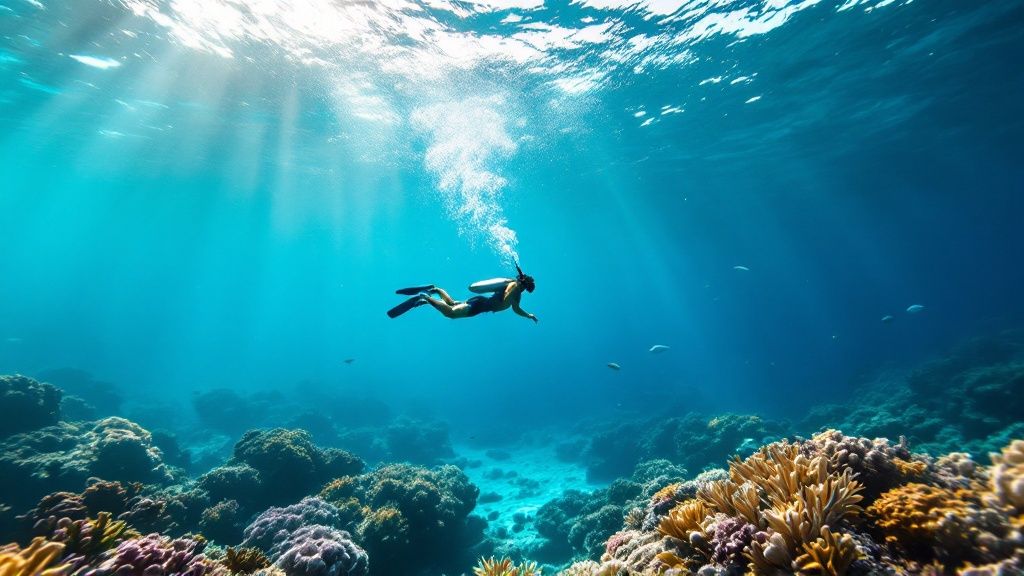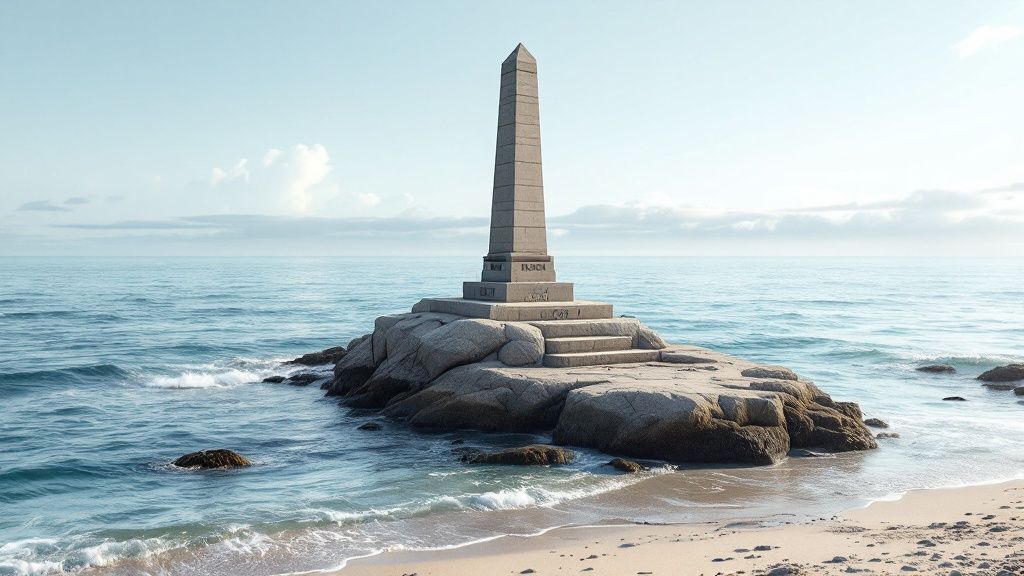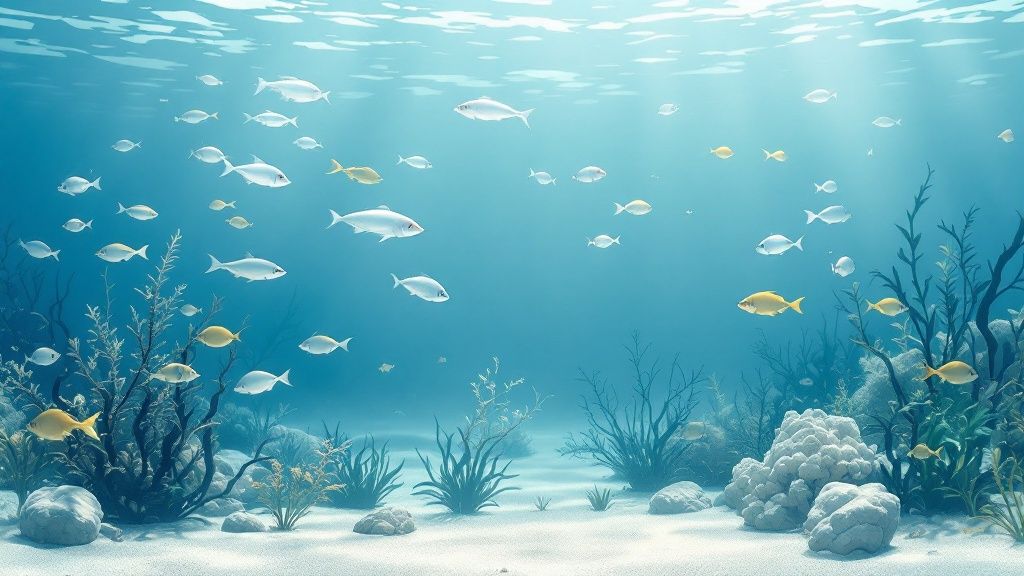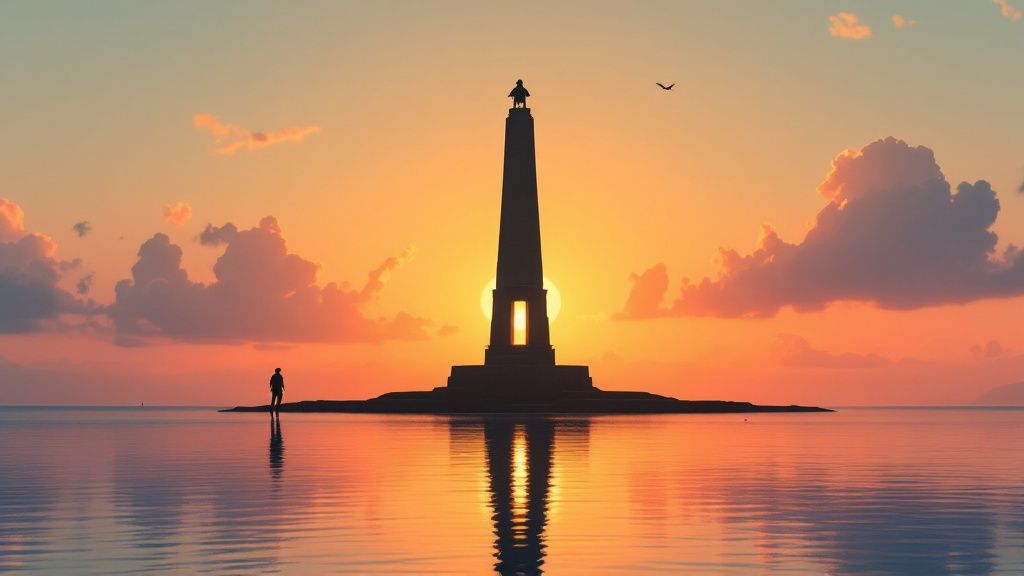Snorkeling Captain Cook Monument Adventure
- Kona Snorkel Trips
- Mar 19, 2025
- 11 min read
Why Snorkeling Captain Cook Monument Transforms Hawaii Adventures

Snorkeling at Captain Cook Monument isn't just a dip in the ocean; it's an immersion into a world where history and nature converge. Imagine vibrant coral reefs teeming with life, crystal-clear waters, and the majestic backdrop of a monument commemorating a significant moment in Hawaiian history. This unique blend sets Captain Cook Monument apart from other snorkeling destinations.
Exceptional Visibility and Marine Biodiversity
The exceptional water clarity is one of the first things you'll notice when Snorkeling Captain Cook monuments waters. Visibility frequently exceeds 100 feet, revealing the intricate details and vibrant colors of the underwater world. This remarkable clarity, combined with the bay's protected status, allows the coral gardens below to thrive. These healthy reefs are vital for supporting a diverse range of marine life, transforming the bay into a living aquarium.
The unique underwater topography of Kealakekua Bay also plays a key role in fostering marine diversity. The bay's depths vary from shallow areas ideal for beginners to deeper sections that attract larger marine species. This means snorkelers of all levels can find a comfortable spot, observing everything from colorful reef fish to graceful sea turtles. Seasonal visitors, like spinner dolphins, further enrich the snorkeling experience.
A Hotspot for Marine Life Enthusiasts
Kealakekua Bay, home to the Captain Cook Monument, attracts over 190,000 visitors annually, making it a true snorkeling hotspot. The bay's popularity stems from its rich history and abundant marine life, including sea turtles, dolphins, and a wide array of fish species. Find more detailed statistics here. With depths ranging from 25 to 153 feet, the bay caters to both novice and experienced snorkelers. The well-developed coral reefs provide shelter and food for a multitude of marine creatures, creating a truly immersive snorkeling experience.
A Blend of History and Natural Wonder
The appeal of snorkeling Captain Cook Monument goes beyond just marine life. The monument marks the spot where Captain James Cook first landed in Hawaii and, later, met his fate. This historical significance adds a unique layer to the snorkeling adventure, connecting you to the past as you explore the present. As you glide over the vibrant coral, you're swimming in the same waters where significant historical events unfolded.
This fusion of natural beauty and historical significance creates an unforgettable experience. It's not simply a snorkeling trip; it’s a journey through time and nature. The memories forged while exploring this special location will resonate long after you've left the islands. This transformation of a typical Hawaiian adventure into something truly remarkable is what draws snorkelers back to Captain Cook Monument again and again.
The Fascinating History Behind Captain Cook Monument

Kealakekua Bay isn't just a beautiful place to snorkel; it's a location rich with history. It's the site of Captain James Cook's arrival in Hawai'i in January 1779, a pivotal moment that forever changed the islands. Snorkeling near the Captain Cook Monument offers a unique way to connect with this history while exploring the vibrant underwater world. You can find more informative articles on our sitemap.
Initial Welcome and Rising Tensions
Captain Cook and his crew were initially welcomed by the Hawaiian people. Some historical accounts even suggest he was mistaken for the god Lono. However, this initial period of hospitality eventually shifted to conflict. Misunderstandings and cultural clashes created growing tension between the British explorers and the native Hawaiians.
The Death of Captain Cook and Its Aftermath
This escalating tension culminated in a tragic confrontation on the shores of Kealakekua Bay, resulting in Cook's death. The precise details surrounding his death continue to be debated by historians. The event, however, undeniably marked a turning point in the relationship between Hawai'i and the Western world.
The Monument and Its Significance
The Captain Cook Monument stands as a physical reminder of this historical encounter. Erected in 1874 by the British, it marks the approximate location of Cook's death. The land surrounding the monument was later deeded to the British government in 1877 for just $1 and remains under British jurisdiction.
Access to the monument is typically by boat, allowing snorkelers to approach directly from the bay. For those who prefer a land-based approach, the 4-mile round-trip Captain Cook Monument Trail offers spectacular views. It is, however, a moderately challenging hike, usually taking between 1.5 and 3 hours. Steep inclines and limited shade make proper preparation essential, including bringing water, sunscreen, and appropriate footwear. Learn more about the Captain Cook Monument trail and snorkeling.
Differing Perspectives on Cook’s Legacy
Captain Cook's legacy is viewed differently from Western and Hawaiian perspectives. While often celebrated as a great explorer in the West, some Hawaiians view his arrival as the beginning of significant cultural and societal change for the islands. This nuanced understanding adds a layer of complexity to the snorkeling experience at the Captain Cook Monument. It serves not only as a historical marker, but also as a place for reflection on the intersection of cultures and the lasting impact of first contact.
Underwater Wonders: Marine Life That Will Take Your Breath Away

The coral gardens beneath the surface at Captain Cook Monument are bursting with life, creating an unforgettable snorkeling experience. This section explores some of the captivating marine life you might encounter, enriching your understanding and appreciation of this underwater paradise. Prepare to be amazed by the diversity and beauty of the creatures that call this place home.
Identifying the Reef's Residents
The waters around the monument are a sanctuary for various species. Schools of dazzling yellow tang shimmer like gold among the coral formations. Their vibrant color makes them easily visible, even for beginners.
Keep an eye out for the curious raccoon butterflyfish, recognizable by their black "masks." These inquisitive fish often swim near snorkelers, creating a personal connection with the underwater world.
The majestic green sea turtles gracefully glide through the water, offering an awe-inspiring spectacle. Their serene presence and effortless movement are mesmerizing.
Time of Day and Marine Activity
The time of day influences the marine activity you'll observe. Early morning offers calm waters and excellent visibility, often the best time to spot larger marine animals.
However, different species have unique rhythms. Some fish are more active during the day, while others prefer twilight. This variation adds an element of surprise to each snorkeling adventure. You might be interested in How to master snorkeling.
Respectful Observation Practices
As you explore, remember you're a visitor in a delicate ecosystem. Respectful observation is essential for preserving this natural wonder.
This means maintaining a safe distance from marine life, avoiding contact with coral, and refraining from feeding the animals. These simple actions significantly impact the reef's long-term health.
Seasonal Visitors and Unique Behaviors
The waters around Captain Cook Monument also welcome seasonal visitors like spinner dolphins, enhancing the snorkeling experience. Witnessing their playful behavior is a special treat.
Each species exhibits unique patterns and interactions, from intricate courtship dances to symbiotic relationships. There's constant activity unfolding beneath the waves. Each snorkeling session becomes a unique underwater safari, offering new discoveries.
The following table highlights some of the marine life you might encounter:
Common Marine Species at Captain Cook Monument: A comprehensive guide to the most frequently spotted marine life while snorkeling at Captain Cook Monument
Species | Description | Best Viewing Depth | Frequency |
|---|---|---|---|
Yellow Tang | Bright yellow, oval-shaped fish often seen in large schools. | Shallow to Medium | Common |
Raccoon Butterflyfish | White and black fish with a distinctive black "mask" around their eyes. | Shallow to Medium | Common |
Green Sea Turtle | Large, graceful reptiles with a smooth, heart-shaped carapace. | Shallow to Deep | Frequent |
Spinner Dolphin | Highly acrobatic dolphins known for their spinning leaps out of the water. | Medium to Deep | Seasonal |
Reef Triggerfish | Colorful fish with a distinctive trigger-like spine on their dorsal fin. | Shallow to Medium | Common |
This table provides a glimpse of the remarkable creatures you might see while snorkeling at Captain Cook Monument. Every visit offers the potential for unique encounters, solidifying its reputation as a world-class snorkeling destination.
Your Complete Guide to Reaching Captain Cook Monument

Reaching the Captain Cook Monument for snorkeling is an adventure in itself. Kealakekua Bay, with its historic significance and natural beauty, offers multiple access points for an unforgettable snorkeling experience. This guide outlines the various options, helping you choose the perfect route to this underwater paradise.
Boat Tours: Comfort and Ease
Boat tours are the most popular way to reach the monument. They provide a comfortable and convenient journey, especially for families and those who aren't strong swimmers. Numerous tour operators depart from several locations along the Kona coast.
Benefit: Many boat tours offer snorkeling gear, snacks, and refreshments, enhancing the overall experience.
Consideration: Tour prices and what's included can differ.
Tip: Reserve your tour ahead of time, particularly during the busy season, to guarantee your spot. Some tours focus on historical details, while others emphasize snorkeling time, so select a tour that aligns with your preferences.
Kayaking: A Personal Adventure
Kayaking to the monument is a rewarding experience for adventurous spirits. This option lets you explore the bay at your own rhythm and soak in the breathtaking coastal views. However, it is a physically demanding journey, involving a paddle of several miles each way.
Essential: Review weather conditions and ocean forecasts before starting your kayak trip.
Permit: Kayaking to the Captain Cook Monument often requires permits or following certain rules. Make sure you're familiar with these requirements beforehand.
Pro Tip: Start your trip early to avoid crowds and enjoy the calmer morning waters. Bring plenty of water and sunscreen.
Hiking the Captain Cook Monument Trail
The Captain Cook Monument Trail offers a land-based route to the monument. This 4-mile round-trip hike is moderately challenging, with steep inclines, uneven terrain, and limited shade. While the hike offers stunning panoramic views of Kealakekua Bay, it's not for the inexperienced hiker.
Preparation: Wear appropriate hiking boots and bring plenty of water, sunscreen, and a hat.
Time: Plan for between 1.5 and 3 hours for the hike each way.
Caution: The trail can be exposed to the elements, so be prepared for intense sun and possible rain.
To help you compare the various access methods, take a look at the table below:
Captain Cook Monument Access Options Compared Comparison of different methods to reach the snorkeling site at Captain Cook Monument
Access Method | Duration | Difficulty | Cost Range | Best For |
|---|---|---|---|---|
Boat Tour | 2-4 hours (including snorkeling time) | Easy | $50 - $150 | Families, those seeking comfort and convenience |
Kayaking | 4-6 hours (depending on pace and stops) | Moderate to Strenuous | $50 - $100 (kayak rental) | Adventurous individuals, those seeking an active experience |
Hiking | 3-6 hours (round trip) | Moderate to Strenuous | Free (parking fees may apply) | Experienced hikers, those seeking scenic views |
This table summarizes the key differences between each access method. Boat tours offer the easiest route, while kayaking and hiking provide more active and challenging alternatives. Consider your fitness level and desired experience when selecting your approach.
Choosing the Right Approach
The ideal way to reach the Captain Cook Monument for snorkeling depends on your personal preferences and physical capabilities. Boat tours offer the most convenient access, kayaking provides an active adventure, and hiking presents a scenic but challenging land-based journey. Each option offers a unique perspective of this remarkable location. Check out our guide on products and services. No matter how you choose to get there, the pristine waters and diverse marine life around the Captain Cook Monument promise an unforgettable snorkeling experience.
The Sacred Waters: Kealakekua Bay's Cultural Significance
Long before Captain James Cook's arrival, Kealakekua Bay held profound spiritual importance for Native Hawaiians. Snorkeling near the Captain Cook monument takes on a deeper meaning when you understand this historical and cultural context. This section explores the bay's significance as a place of ceremony, reverence, and connection to the divine.
A Place of Sanctuary and Divine Connection
For centuries, Kealakekua Bay was more than just a picturesque location; it was a spiritual hub. The bay's calm waters and thriving marine life nurtured a deep connection with nature, a cornerstone of Hawaiian spirituality. Traditional practices honored the abundance of these waters, recognizing the interconnectedness of all living things. This respect permeated every aspect of life in and around the bay, transforming a snorkeling trip into an encounter with profound cultural meaning.
Ancient Temples and Cultural Practices
Physical remnants of this spiritual heritage are still visible around the bay. Ancient temples, known as heiau, once stood along the shores, serving as centers for ceremonies and offerings. The Hikiau Heiau, a particularly important temple, remains a powerful testament to the bay's significance in Hawaiian culture. These structures provided a space where the spiritual and physical worlds intersected, strengthening the bond between humans and the divine.
Kealakekua Bay's historical importance goes beyond its association with Captain James Cook. It was a sacred site for ancient Hawaiians, playing a vital role in their culture. The Hikiau Heiau, a temple dating back to the 1500s, underscores the bay's cultural richness. The area's history, combined with its natural beauty and biodiversity, makes it a unique destination for history buffs and nature lovers alike. Visitors can explore not only the monument but also the surrounding historical sites, deepening their understanding of Hawai'i's past. Learn more about the depth and dimensions of Kealakekua Bay here. For those interested in historical research, this resource might be helpful: How to master historical research.
A Living Heritage Landscape
Despite the passage of time, Kealakekua Bay remains a living heritage landscape. Hawaiian traditions continue to be honored and preserved, enriching the experience of snorkeling near the Captain Cook monument. Understanding the area's cultural significance allows visitors to appreciate the bay's rich history and enduring spiritual power. This awareness transforms a recreational outing into a meaningful journey, fostering respect for the traditions that have shaped this remarkable place. Experiencing Kealakekua Bay with this perspective offers a powerful connection to the heart of Hawaiian culture.
Mastering Your Captain Cook Monument Snorkeling Adventure
Snorkeling Captain Cook Monument isn't just about getting wet; it's about truly experiencing this incredible location. Understanding Kealakekua Bay can transform your snorkeling from memorable to exceptional. This means knowing when to go, where to enter, and how to handle the bay's currents.
Timing Is Everything: Ideal Snorkeling Conditions
Early morning is the perfect time to snorkel at Captain Cook Monument. The water is generally calm, offering glassy conditions and superb visibility. The wind, which can stir up sediment, is usually minimal in the early hours. You'll have the clearest views of the reef and its inhabitants.
Strategic Entry Points: Minimizing Swim Distance
Choosing the right entry point can significantly improve your snorkeling experience. Some spots in Kealakekua Bay minimize the swim to the best coral formations and increase your chances of seeing diverse marine life. Entering near the monument offers almost immediate access to thriving coral gardens. Other entry points might require a longer swim. Strategic planning is especially helpful for less experienced snorkelers or those with limited time.
Navigating Kealakekua Bay's Currents
Understanding Kealakekua Bay's current patterns is key to a successful snorkeling trip. While generally mild, currents can vary depending on the time of day and weather. Knowing how these currents flow helps you conserve energy and stay in your desired snorkeling area. You might be interested in: How to master snorkeling techniques related to currents and navigation. Think of it as navigating a lazy river; going with the flow makes exploration much more enjoyable.
Underwater Landmarks: Navigating Like a Pro
Once underwater, familiarizing yourself with landmarks helps you stay oriented. Distinctive coral formations, rock outcroppings, and even particular coral species can serve as natural navigation points. This knowledge lets you explore with confidence, knowing you can easily return to your entry point. For experienced snorkelers, this opens up more adventurous exploration.
Efficient Fin Techniques: Extending Your Exploration
Mastering efficient fin techniques can significantly extend your snorkeling time and reduce fatigue. Use long, slow kicks for minimal effort. Avoid short, choppy kicks that waste energy and stir up sediment, reducing visibility. Proper finning helps you cover more ground and fully immerse yourself in the underwater world.
Equipment Recommendations and Potential Challenges
The right equipment enhances your experience and ensures your safety. While basic snorkeling gear is readily available, consider a high-quality mask and snorkel for optimal comfort and clear vision. Cressi fins designed for snorkeling can greatly improve efficiency and maneuverability.
Challenges might arise, such as changing weather or strong currents. Be prepared. Check the weather forecast and be aware of potential hazards.
Responsible Snorkeling Practices: Preserving Kealakekua Bay
Kealakekua Bay is a fragile ecosystem. Responsible snorkeling is vital for its preservation. Never touch the coral, as even slight contact can cause damage. Maintain a safe distance from marine life and avoid feeding them. By following these guidelines, you can help keep the bay pristine.
Whether you're a seasoned snorkeler or a beginner, these tips can elevate your Captain Cook Monument snorkeling adventure. By mastering these aspects, you not only enhance your experience but also contribute to the bay's health. Explore the wonders of Kealakekua Bay with us.
